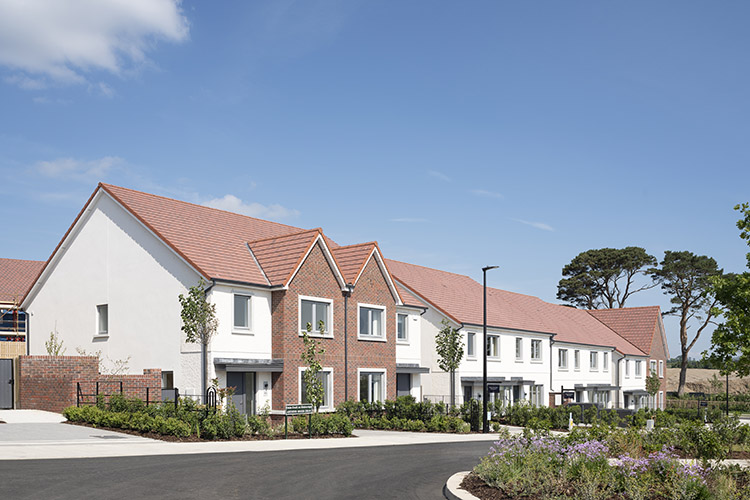“Developers not shying away from sustainability responsibilities”
#BuildingLife Ambassador and ESG Manager with Cairn Homes plc Susie Crawford speaks to ROBBIE COUSINS about the role of ESG in the house builder’s operations and the appetite in construction to halve its carbon emissions by 2030 and reach carbon neutrality by 2050
The Irish Green Building Council’s (IGBC’s) #BuildingLife campaign aims to achieve a broad range of private sector actions and public policy changes required to tackle the whole-life environmental impact of buildings.
The appointment of #BuildingLife ambassadors from across industry and politics is an integral part of the campaign. The role of these ambassadors is to champion #BuildingLife goals and help drive change around sustainability within their sectors and across the construction industry.
In 2018, Cairn Homes plc (Cairn), following engagement with investors, began to develop an Environmental Social and Governance (ESG) business model that emphasises responsible construction and development while in the process of maintaining a viable business and contributing much-needed supply amidst the housing crisis.
A core objective of this approach was to put the housing developer on a more sustainable footing by reducing the embodied and operational carbon of the business and its developments.
This not only spoke to the concerns of investors but other stakeholders, such as employees, potential employees and the communities in which it is building, as well as local authorities and its own supply chain.
Cairn’s ESG Manager Susie Crawford joined the company in 2019 as an economic advisor on investor relations. For many investors, ESG has moved centre stage. Since joining Cairn, much of her work has involved compiling and analysing economic, sustainability and social data and reporting to investors and the Cairn senior management team.
“Our inaugural Sustainability Report in 2021 gives a broad overview with case studies of our approach to ESG,” Susie Crawford explains. “This informs investors and stakeholders, which includes our customers, employees, prospective employees, government departments, local authorities and communities, on our overall approach, and enabled us to identify ways in which we can make a difference in terms of playing a positive role in addressing climate change and social issues and aligning this with our overarching strategy and key priority areas.”
#BuildingLife Campaign
Cairn has an established relationship with the IGBC, and increased engagement with the IGBC was a natural progression for the company as sustainability and ESG became central to its business strategy.
“Once ESG came into play, we wanted to position Cairn as a leader in this area, and IGBC had an extensive range of programmes and training aligned with our ambition, Crawford notes. “It also presented an opportunity for us to engage with our peers and to contribute to the learning process, and, in turn, learn from others about how we all approach the same sustainability challenges.”
She continues, “I was delighted to take on the role of IGBC #BuildingLife ambassador. In this, I engage with IGBC on their many programmes, keeping an eye on key training opportunities for the Cairn team, such as a recent life-cycle carbon cost analysis training module, which was beneficial to members of our QS team. I also engage with colleagues within Cairn, our supply chain and peers from other companies about key sustainability issues.”
Sustainability at Cairn Homes
According to the international Green House Gas (GHG) Protocol, a company’s greenhouse gas emissions are classified into three scopes. Scopes 1, 2 and 3 categorise carbon emissions a company creates in its operations and its wider value chain.
Scope 1 emissions are GHG emissions that a company makes directly, for example, consuming energy to run plant and vehicles.
Scope 2 emissions are indirect emissions, eg, electricity generated through the national grid.
Scope 3 emissions are ”upstream and downstream”, ie, products manufactured, or, in Cairn’s case, buildings constructed.
From a sustainability perspective, the two key priority areas for Cairn are climate impact and biodiversity.
“Scope 1 and scope 2 are emissions that Cairn directly manages,” Susie Crawford comments. “We purchase electricity and diesel for use in company vehicles, generators and other on-site plant. The earlier we can get connected to the grid, the less the need for generators; so lower diesel usage results in a lower carbon footprint. Beyond that, we are looking at piloting hydrotreated vegetable oils as a replacement for diesel.
“Looking at reducing emissions from the electricity we use, we are moving towards fully certified renewable sources of electricity. What we cannot reduce, we aim to make as green as possible.
“Scope 3 emissions are more complex to address. But, this has driven innovation in Cairn around how we design and construct our developments.
“Firstly, the most significant of our scope 3 emissions are embodied carbon and the carbon associated with the energy in use of the homes we build. The IGBC has been very helpful in providing resources and training to inform our people about embodied carbon and identifying the most important components we can address. For example, how would we go about reducing embodied carbon associated with concrete and steel? This could be achieved with leaner design and substitution with more sustainable materials. For example, low-carbon cement, timber frame or LGS, and removing unnecessary columns or walls in our developments.
“Next is how can we address operational energy required in homes once we hand them over. The way that we design and build affects the energy demand in any given building, and reducing the need for energy to heat, cool or power that building is the key.
“Heating energy requirements can be reduced by having airtight buildings with high-performing glazing. Cairn has a specified minimum A2 BER rating for all our homes, and we are always looking for ways to improve this.”
Biodiversity net gain
Susie Crawford continues, “Biodiversity is a key area of focus for Cairn, and we are targeting ‘Biodiversity Net Gain’, whereby the biodiversity on the development should be enhanced relative to the position on the site prior to development. This is achieved by providing protection for existing species, wherever possible, and then providing quality habitats during construction and in the new development. Cairn has taken the market-leading approach of including this target in executive remuneration.”
Environmental Product Declarations
Environmental product declarations (EPDs) are a standardised way of providing data about the environmental impacts of a product through the product life cycle. Cairn encourages all of its supply chain to provide EPDs.
“We use EPDs to undertake life-cycle assessments on our homes. The more accurate the underlying information we have on each component, the more accurate our estimate of the carbon footprint can be. The more accurate the EPD for each product is, the more likely we are to say, ‘okay, this one is slightly more expensive, but the embodied carbon is much lower’, and we might choose it for that reason.
“When we build up the picture of overall embodied carbon in a building, we can then identify the most carbon-intensive elements and try to reduce these. For example, concrete is an essential building material, but some concrete products have more embodied carbon than others. With an EPD, we can compare one concrete against another and make an informed product choice on that basis.”
Innovation at Cairn
Innovation has a key role to play in reducing the embodied carbon in the houses that Cairn builds, and the company has been very successful at encouraging staff at all levels to submit new ideas to improve its operations and reduce its carbon footprint.
“When considering how we might reduce the embodied or operational carbon in our developments, there may be a new product or process that could be brought in, or there might be a problem for which there is a solution that we don’t know about yet.
“Innovation is said to be driven by necessity, but it is also driven by the range of experiences of everyone in a business. So, we have an innovation forum at Cairn in which we encourage all of our staff to participate.
“Anyone can submit an idea or solution through the forum. A team, including a technical manager, follows a process to evaluate submissions. We see if the proposal will work technically, look at its commercial viability, and finally assess it to see if it makes sense from a sustainability perspective. If deemed feasible, it then goes through a pilot process before being rolled out.
“Examples of ideas that have been very successful include rapid impact compaction where site conditions allow, and the use of LGS. We are also looking to roll out hydrotreated vegetable oils as a replacement for diesel.”
Social responsibility at Cairn
“The social impact of what we do has never been more relevant,” Crawford comments. “We, as a society, are in the middle of a cost-of-living crisis at this time. From Cairn’s perspective, we look at how what we do impacts our customers’ lives, and ask what we can do to better so that the communities we build for them contribute more to their well-being.
“Cairn’s purpose is ‘Building homes and creating places where people love to live’.” Susie Crawford continues. “’Where people love to live’ is the key phrase for us. It means that we want every Cairn development to be community-centric and give our customers opportunities to gel with their own communities and develop links with established neighbouring communities. To this end, within our sustainability strategy, we have an initiative called ‘Home Together’. Our approach to stimulating community engagement and interaction involves supporting local leaders to build resilient inclusive groups in a way that is authentic for our customers and their needs. We do this by finding out what residents are interested in doing with their community and then providing them with tools to make this happen, for example, hosting events such as coffee mornings or dog shows.”
Staff development
As a company, Cairn has a comprehensive approach to developing its people. Crawford comments, “We invest a lot in ensuring that our people, particularly new recruits, get the support needed to develop new skills and maintain positive well-being, including offering CPD training supports and ensuring there is a trained mental health first-aider on every site.”
She continues, “A major challenge for the construction industry as a whole remains the area of equality, diversity and inclusion (EDI), particularly gender diversity. Gone is the day when construction was about laying blocks. There’s so much more to it. Yet we still have an industry where female representation is far too low, standing at just over 9% here as compared to over 19% in the transportation industry or 14% in construction in the UK . There has been much focus on improving EDI in the sector in recent years, and, while we are proud to have reached 26% female participation at Cairn, continuously improving this remains a priority.”
In conclusion
Susie Crawford notes there has been a real buzz around sustainability since the reopening of social engagement in the sector after the Covid-19 pandemic.
She comments, “Since being able to attend events in person once more, I have noted a massive change in attitudes towards sustainability. There is now great momentum behind the sustainability movement. I can see this, particularly in our engagement with IGBC. By being innovative, contractors and suppliers are reducing their carbon footprints and bringing biodiversity gains into property development.
“The launch of the new IGBC Roadmap to decarbonise Ireland’s construction and built environment sector shows that major developers and contractors are not shying away their sustainability responsibilities. As an industry, we are embracing new ways of working and reducing embodied carbon in developments. It is no longer a case of asking ‘will we or won’t we’; the question now being asked and answered is, ‘How are we going to do this?’” she concludes.








